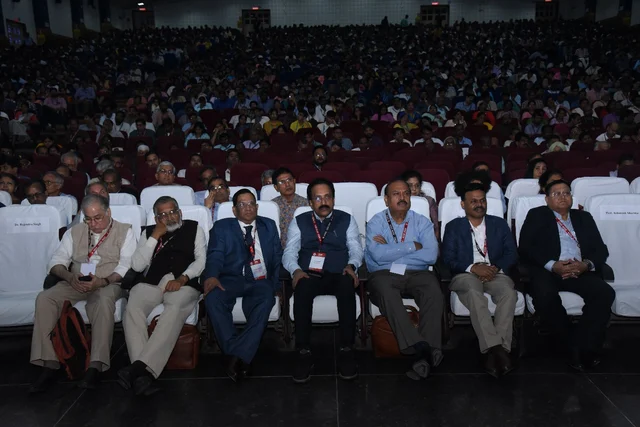The 90th Annual General Meeting of the Indian National Science Academy (INSA) witnessed the participation of top Scientists from India and a few experts from industries. The inauguration ceremony was graced by Dr. P. Sathyanarayanan, Pro Chancellor (Academics) of SRM Institute of Science and Technology (SRMIST).
In his address, Dr. Sathyanarayanan expressed his gratitude to INSA for hosting the meeting at SRMIST and emphasized India’s rich legacy in research and innovation. “India has always been at the forefront of research in fields such as Mathematics, Astronomy, And Metallurgy, thanks to our culture of innovation,” he said. He further highlighted the crucial role of education in the nation’s prosperity and urged the promotion of start-ups.
In his presidential address, Prof. Ashutosh Sharma, President of INSA, discussed “Structure and Processes of S & T and the Question of Sustainability.” He addressed the key challenges, including the structure and functioning of science and technology, its strengths and weaknesses, and the role of new thinking in overcoming these challenges. The meeting also saw the convergence of some of India’s leading scientific luminaries, creating a platform to celebrate achievements, share insights, and engage in critical discussions shaping the future of science and technology in India.
The two-day event brought together over 200 participants, including INSA Fellows, early-career researchers, young innovators, and other members of India’s scientific community. Distinguished attendees included Dr. Anil Kakodkar, Chancellor of Homi Bhabha National Institute; Dr. V.K. Saraswat, Member of NITI Aayog, GoI; Dr. S. Somanath, Chairman of the Space Commission and ISRO; Dr. S. V. Kamat, Secretary of the Department of Defence R&D and Chairman of DRDO; Dr. Krishna M. Ella, Executive Chairman of Bharat Biotech; Dr. K. N. Sivarajan, Chief Technology Officer of Tejas Networks; Dr. Abhay Bang, Founder Director of SEARCH (Society for Education, Action, and Research in Community Health); and Mr. S. Kris Gopalakrishnan, Chairman of Axilor Ventures, among others.
The event featured a carefully curated program, which included the Council Meeting, lectures by Newly Elected Fellows and Foreign Fellows, INSA Distinguished Lectures, and presentations from INSA Young Associates, Associate Fellows, and History of Science Young Associates. The gathering also included the induction of new Fellows and the felicitation of outgoing Council members for their invaluable contributions to the Academy. The 90th Annual General Meeting abstracts of INSA was released on the occasion.
During his presentation on “Inevitability of Thorium for Energy Security of a Developed India,” Dr. Anil Kakodkar elaborated on the critical role of nuclear energy in India’s development. He stated, “India’s uranium resources offer insurance against uranium supply disruptions, and India’s thorium resources are the largest in the world. With a closed fuel cycle, India can achieve energy self-sufficiency from its current energy-starved situation.”
Dr. Kakodkar further mentioned India’s achievements over the years, including self-reliance in nuclear weapons, nuclear submarines, PHWRs, access to uranium, and the closing of the first-stage fuel cycle reactor (nearly complete). He also highlighted challenges ahead, including the need to increase the share of nuclear energy deployment, shrink spent fuel inventories, scale up thorium deployment, and advance technologies for high-temperature reactors, hydrogen production, and recycling technologies.
Dr. S. Somanath, gave an insightful presentation on “Space Exploration in Amrit Kaal.” He shared recent milestones from India’s space missions, particularly Chandrayaan-3, Aditya L1, and XPoSat. “These three missions reflect the renewed emphasis on exploration. For instance, Chandrayaan-1 helped us discover the presence of water molecules on the moon, and Chandrayaan-3 provided key data about the moon’s elemental composition, helping to understand its origin,” he said.
Dr. Somanath also discussed AstroSat, India’s first multi-wavelength space observatory, which has the unique ability to observe astronomical objects across a wide range of wavelengths, from ultraviolet to gamma rays, much like the Hubble Space Telescope.
“These space missions are part of India’s broader vision for space exploration, which is aligned with the nation’s long-term goal for 2047, “Innovative Beyond Earth Bound.” The objective is to expand and explore India’s space programs and related activities, driving innovation and advancements in space technology.
Dr. S. V. Kamat, shared insights into the future of defence R&D. He remarked, “Technology obsolescence occurs within 5-10 years. Disruptive technologies like AI/ML, quantum technology, and advanced materials are playing a significant role in reshaping military capabilities globally.” He also emphasized that the nature of warfare is shifting from traditional domains like air, land, and sea, to new arenas such as space, cyber, and information warfare.
Dr. Kamat stressed the importance of encouraging start-ups and MSMEs, which are more flexible and innovative, and of fostering collaboration between academia and industry in basic and applied research, especially in futuristic technologies. “Innovation must be driven by R&D in next-generation technologies to ensure leadership in defence and beyond,” he concluded.
Dr. V.K. Saraswat in his presentation he explored India’s tech revolution during sustainable economic growth’. He emphasized the phenomenal growth of science and technology in recent decades, noting how innovations have enhanced the quality of life while presenting opportunities for further exploration and breakthroughs.
He underscored the importance of the 17 Sustainable Development Goals (SDGs) as a comprehensive framework to address global environmental, social, and economic challenges. Highlighting the need to protect the planet, he emphasized climate action, biodiversity conservation, and the adoption of a circular economy to mitigate the adverse effects of technological progress.
Dr. Krishna Ella spoke on ‘Vaccine Innovation, Global Health Challenges, and India’s Role in Public Health’. Speaking on his approach, Dr. Ella said, “I see a problem as an opportunity to solve societal challenges.” His company has supplied over 10 million vaccine doses across 118 countries, underscoring India’s role in global health innovation.
Reflecting on the geopolitics of public health, Dr. Ella acknowledged the challenges faced by Indian science and technology on the global stage. Despite being the third country in the world to develop a COVID-19 vaccine, Indian innovations often encounter skepticism. Dr. Ella urged the scientific community to collaborate and counter misinformation while showcasing India’s capabilities in health innovation.
Dr. K. N. Sivarajan’s presentation was on ‘Science and the Present Generation of Communication.” He highlighted how advancements in fields such as physics, material science, and biology have revolutionized communication technologies, from enabling system-on-chip (SoC) architectures to AI-native communication systems inspired by the biology of neurons.
Dr. Abhay Bang discusses groundbreaking Community Health. One of his most influential contributions is the development of a home-based newborn care approach, which has reduced infant mortality rates from 121 to just 30 per 1,000 live births. This model has been successfully implemented in 10 countries, revolutionizing maternal and child healthcare worldwide.
During his speech, Dr. Bang shared insights into the research process, discussing the challenges faced while conducting studies in remote areas. He highlighted two compelling stories from his work in Gadchiroli (India), a district known for its severe poverty and tribal population, which makes healthcare delivery particularly challenging.
Mr. Senapathi Kris Gopalakrishnan’s company Axilor Ventures and Axilorator has helped start-ups during the early stage of their business journey. He focused on what opportunities and emerging technologies that provide & transform India into the developed nations for the next 20-30 years.
SRM Institute of Science and Technology is a multi-diversity university that is accredited by NAAC with the highest A++ grade. To know more about the institution visit www.srmist.edu.in




